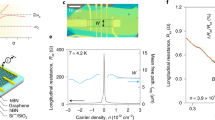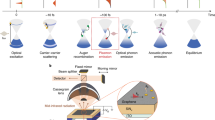Abstract
The phenomena of single-layer graphene resonant photoluminescence and Raman radiation are discussed taking into account the photo-generated electron–hole Coulomb interaction. On the base of general principles of a many-particle interactions and the interband resonance optical transitions a photon radiation new mechanism (Coulomb mechanism) is proposed. Through Stokes 2D'-mode particular case analysis has shown that the graphene photoluminescence and the resonant Raman radiation are characterized by the same frequency shifts. Probabilities of resonance photo-radiation processes have been presented where the electron–hole Coulomb attraction has been taken into account. The probabilities are the same fourth-order small values. The weak photo-radiation Coulomb mechanism has a common character. It is applicable to both zero and nonzero band gap crystals.


Similar content being viewed by others
References
Long DA (2002) The Raman Effect: A Unified Treatment of the Theory of Raman Scattering by Molecules. John Wiley & Sons, UK
Lounis SD, Siegel DA, Broesler R et al (2010) Photoluminescent charging of epitaxial graphene. App Phys Lett 96:151913–1–151913–3
Cao LI, Meziani MJ, Sahu S, Sun YP (2013) Photoluminescence properties of graphene versus other carbon nanomaterials. Acc Chem Res 46:171–180
Malekpour H, Balandin AA (2018) Raman based technique for measuring thermal conductivity of graphene and related materials. J Raman Spectrosc 49:106–120
Wu JB, Lin ML, Cong X, Liu HN, Tan PH (2018) Raman spectroscopy of grapheme based materials and its applications in related devices. Chem Soc Rev 47:1822–1873
Cong X, Li QQ, Zhang X, Lin ML., Wu JB, Liu XL, Venezuela P, Tan PH (2019) Probing the acoustic phonon dispersion and sound velocity of graphene by Raman spectroscopy. Carbon 149:19–24
Hahnlein B, Lebedev SP, Eliseyev IA, Smirnov AN, Davydov VY, Zubov AV, Lebedev AA, Pezoldt J (2020) Investigation of epitaxial graphene via Raman spectroscopy: Origins of phonon mode asymmetries and line width deviations. Carbon 170:666–676
Costa SD, Righi A, Fantini C et al (2012) Resonant Raman spectroscopy of graphene grown on cooper substrates. Solid State Commun 152:1317–1320
Beams R, Cancado LG, Novotny L (2015) Raman characterization of defects and dopants in graphene. J Phys Condens Matter 27:083002 (26pp). https://doi.org/10.1088/0953-8984/27/8/083002
Sato K, Saito R, Oyama Y et al (2006) D-band Raman intensity of graphitic materials as a function of laser energy and crystallite size. Chem phys Lett 427:117–121
Yoon D, Moon H, Cheong H et al (2009) Variations in the Raman spectrum as a function of the number of graphene layers. J Korean Phys Soc 55:12991–1303
Ferreira HM, Moutinho MVO, Stavale F et al (2010) Evolution of the Raman spectra from single-, few- and many-layer graphene with increasing disorder. Phys Rev B 82:125429-1–125429-9
Ferrari AC, Basko DM (2013) Raman spectroscopy as a versatile tool for studying the properties of graphene. Nature Nanotrchnol 8:235–246
Hulman M (2014) Raman spectroscopy of graphene. In: Skakalova V., Kaiser A. B. (eds) Graphene, 1st edn. Woodhead publ, Elsevier, pp 156–183. https://doi.org/10.1533/9780857099334.2.156
Basko DM (2008) Theory of resonant multiphonon Raman scattering in graphene. Phys Rev B 78:125418-1–125418-42
Melkonyan SV (2017) On the thoery of intravalley Raman scattering in intrinsic graphene. In: Proceedings of 11th international conference on semicond micro-and nanoelectronics, Yerevan, Armenia, 9–13
Venezuela P, Lazzeri M, Mauri F (2011) Theory of double-resonant Raman spectra in graphene: intensity and line shape of defect-induced and two-phonon bands. Phys Rev B 84:035433-1–035433-25
Thomsen C, Reich S (2000) Double resonant Raman scattering in graphite. Phys Rev Lett 85:5214–5217
Anselm AI (1981) Introduction to semiconductor theory. Mir, Moscow
Davydov AS (1976) Solid state theory (Russian edition). Nauka, Moscow
Gantmakher FV, Levinson IB (1987) Carrier scattering in metals and semiconductors. Elsevier Science Publ. Amsterdam, The Netherlands
Tarasov LV (2008) Introduction to quantum optics (Russian edition). LKI, Moscow
Author information
Authors and Affiliations
Corresponding author
Additional information
Publisher's Note
Springer Nature remains neutral with regard to jurisdictional claims in published maps and institutional affiliations.
Rights and permissions
About this article
Cite this article
Melkonyan, S.V. Coulomb mechanism of Raman radiation in graphene. Carbon Lett. 31, 1051–1059 (2021). https://doi.org/10.1007/s42823-020-00220-3
Received:
Revised:
Accepted:
Published:
Issue Date:
DOI: https://doi.org/10.1007/s42823-020-00220-3




